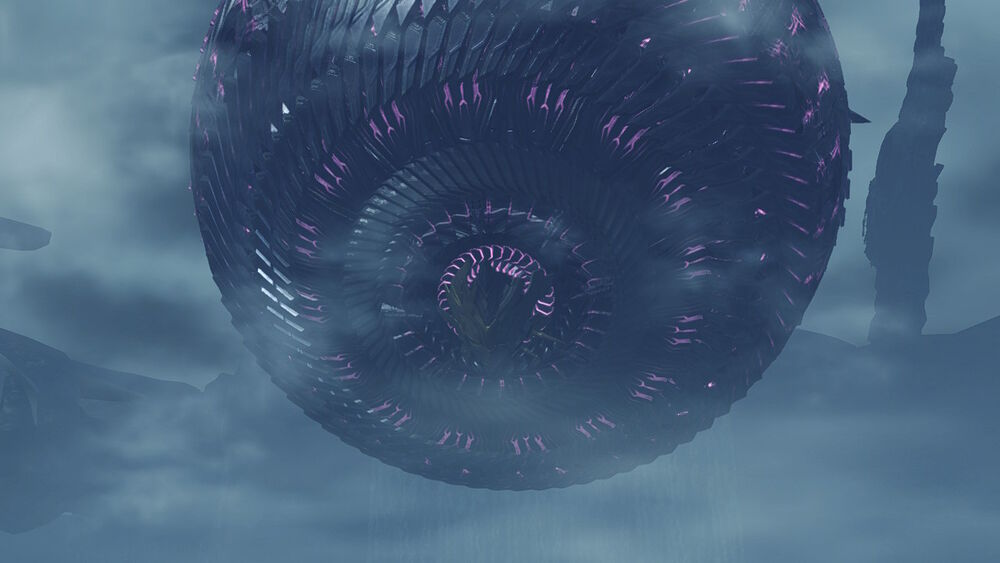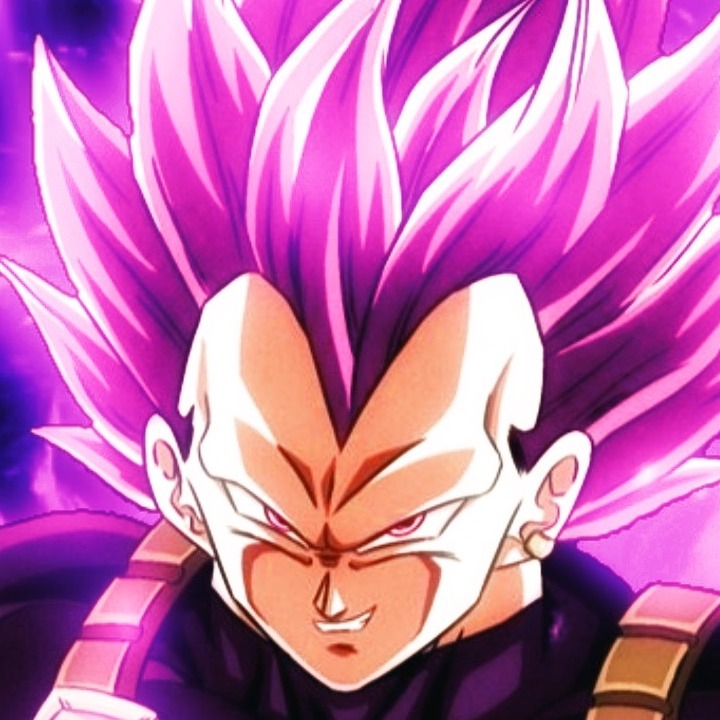Christi Junior on Nostr: 6/8 The quality of the storytelling takes a major hit in other ways as well during ...
6/8
The quality of the storytelling takes a major hit in other ways as well during Chapter 7. After the six previous chapters all boasted near-perfect pacing, this final chapter is suddenly all over the place: Blatant padding, in the form of having to collect Origin Metal in various locations (reminiscent of Zelda: The Wind Waker’s infamous Triforce Shard collect-a-thon) in order to upgrade your boat so it can reach Origin, is coupled with a rushed, mandatory Side Story for Noah, which in many ways feels like an inferior version of Mio’s Side Story from the chapter before. It again features an old friend coming back from the dead as an enemy, though this time the twist is that he’s actually Moebius (which is ALSO old hat at this point of the game). And while this character has already been established much earlier in the story, the game chooses to cram so much of his backstory into this very short section that when it later shows various flashback scenes of him in order to stir your emotions, *they’re all flashback scenes you already saw just an hour ago*, which greatly diminish their impact.
Moreover, this particular storyline does surprisingly little for Noah, because his character arc already felt nearly complete by the beginning of Chapter 7 – the only things that really remain are for him to confront N again, confess his true feelings for Mio, and defeat Z. Taking a trip down memory lane and confronting an old friend with some truly muddled motivations just rethreads familiar ground, and the earlier, similar storylines were all handled better.
It’s not just the storytelling, but also the presentation that’s weaker than in the previous chapters: there’s way fewer of those amazing action scenes that Xenoblade has become known for, with even something like the rematch with N being done on the cheap, in stark contrast to something like Rex’s final battle with Jin. Earlier, when our heroes piloted their upgraded boat through various obstacles and finally break into Origin, we did get a nice enough action sequence, but one that paled in comparison to Xenoblade 1’s Star Wars-inspired aerial combat scenes of Junks making its way into Mechonis. And of course, Consuls X and Y get dealt with in a ridiculously rushed and anti-climactic fashion. The final battle itself is admittedly the occasion for some truly epic action scenes, but that’s to be expected, and doesn’t save chapter 7 from feeling quite rushed on the whole.
That said, even though Chapter 7’s storytelling and presentation is a step down from what we’d seen in previous chapters, that hardly means its bad by regular JPRG standards; messy backstory and unsatisfying handling of moral dilemmas notwithstanding, it’s still an enjoyable ride that kept me emotionally invested throughout, and the character writing mostly remains on point – indeed, the addition of Nia to the cast is extremely welcome, and as much as I would like more legacy Xenoblade characters to have been properly featured (as in, not just represented as souls residing within inanimate objects), Nia herself could hardly have been handled better. Meanwhile, Melia’s role is far smaller (it’s only in the post-game that she truly gets to shine), but she still gets some good moments.
While not introducing a lot of new areas, Chapter 7 is where you finally liberate Keves Castle, and while Agnus Castle didn’t really boast much in terms of surrounding towns (unless you count the prison), its Kevesi counterpart is connected to Fort O'Virbus, one of Xenoblade 3’s few proper towns (as in, not a Colony), with some great original music to its name (as opposed to the regular Keves Colony theme), and a really cool, unique look to it that seems to fuse the civilizations of Bionis and Mechonis – extremely fitting for the capital of the Xenoblade 1 world. It is however kinda surprising to me that this is one of the very last locations you gain access to, because Fort O'Virbus and even its music were featured somewhat prominently in both pre-release trailers and the Xenoblade 3 Direct.
But of course, the real highlight of this chapter is Origin, or rather the inside of Origin, which you traverse on your way to the final confrontation with Z. And I gotta say, Origin was pretty much EXACTLY what I hoped it would be in terms of design and look – not only a massive (if somewhat linear) final area, but visually striking and extremely distinct. Whereas so many Xenoblade 3 areas opted for more muted color palettes and somewhat “realistic” settings (by Xenoblade standards), Origin is dominated by strong, bold purple colors and takes full advantage of the sci-fi fantasy setting, showing off bizarre technology and being filled with massive core crystal-like objects that hint at how this baffling Ark actually works, making for some nice, understated visual storytelling.
I’m still inclined to argue that Origin isn’t *quite* as cool as an area like the Central Factory in Xenoblade 1, but it’s easily superior to Xenoblade 2’s World Tree. Moreover, at this point in the game you probably have such a wealth of different, extremely fun Classes and team combinations to play around with that the core gameplay and combat is absolutely sublime. This is what I meant when I during the Chapter 1 writeup argued that the opening chapter made for a very misleading introduction to Xenoblade 3: back then, the storytelling and pacing was near-perfect, while the gameplay was heavily flawed, bogged down by frequent forced tutorials and extremely restricted combat options. However, as the game draws to a close we now get to enjoy absolutely superb gameplay and near-unlimited combat customization options, while having to deal with highly erratic storytelling.

The quality of the storytelling takes a major hit in other ways as well during Chapter 7. After the six previous chapters all boasted near-perfect pacing, this final chapter is suddenly all over the place: Blatant padding, in the form of having to collect Origin Metal in various locations (reminiscent of Zelda: The Wind Waker’s infamous Triforce Shard collect-a-thon) in order to upgrade your boat so it can reach Origin, is coupled with a rushed, mandatory Side Story for Noah, which in many ways feels like an inferior version of Mio’s Side Story from the chapter before. It again features an old friend coming back from the dead as an enemy, though this time the twist is that he’s actually Moebius (which is ALSO old hat at this point of the game). And while this character has already been established much earlier in the story, the game chooses to cram so much of his backstory into this very short section that when it later shows various flashback scenes of him in order to stir your emotions, *they’re all flashback scenes you already saw just an hour ago*, which greatly diminish their impact.
Moreover, this particular storyline does surprisingly little for Noah, because his character arc already felt nearly complete by the beginning of Chapter 7 – the only things that really remain are for him to confront N again, confess his true feelings for Mio, and defeat Z. Taking a trip down memory lane and confronting an old friend with some truly muddled motivations just rethreads familiar ground, and the earlier, similar storylines were all handled better.
It’s not just the storytelling, but also the presentation that’s weaker than in the previous chapters: there’s way fewer of those amazing action scenes that Xenoblade has become known for, with even something like the rematch with N being done on the cheap, in stark contrast to something like Rex’s final battle with Jin. Earlier, when our heroes piloted their upgraded boat through various obstacles and finally break into Origin, we did get a nice enough action sequence, but one that paled in comparison to Xenoblade 1’s Star Wars-inspired aerial combat scenes of Junks making its way into Mechonis. And of course, Consuls X and Y get dealt with in a ridiculously rushed and anti-climactic fashion. The final battle itself is admittedly the occasion for some truly epic action scenes, but that’s to be expected, and doesn’t save chapter 7 from feeling quite rushed on the whole.
That said, even though Chapter 7’s storytelling and presentation is a step down from what we’d seen in previous chapters, that hardly means its bad by regular JPRG standards; messy backstory and unsatisfying handling of moral dilemmas notwithstanding, it’s still an enjoyable ride that kept me emotionally invested throughout, and the character writing mostly remains on point – indeed, the addition of Nia to the cast is extremely welcome, and as much as I would like more legacy Xenoblade characters to have been properly featured (as in, not just represented as souls residing within inanimate objects), Nia herself could hardly have been handled better. Meanwhile, Melia’s role is far smaller (it’s only in the post-game that she truly gets to shine), but she still gets some good moments.
While not introducing a lot of new areas, Chapter 7 is where you finally liberate Keves Castle, and while Agnus Castle didn’t really boast much in terms of surrounding towns (unless you count the prison), its Kevesi counterpart is connected to Fort O'Virbus, one of Xenoblade 3’s few proper towns (as in, not a Colony), with some great original music to its name (as opposed to the regular Keves Colony theme), and a really cool, unique look to it that seems to fuse the civilizations of Bionis and Mechonis – extremely fitting for the capital of the Xenoblade 1 world. It is however kinda surprising to me that this is one of the very last locations you gain access to, because Fort O'Virbus and even its music were featured somewhat prominently in both pre-release trailers and the Xenoblade 3 Direct.
But of course, the real highlight of this chapter is Origin, or rather the inside of Origin, which you traverse on your way to the final confrontation with Z. And I gotta say, Origin was pretty much EXACTLY what I hoped it would be in terms of design and look – not only a massive (if somewhat linear) final area, but visually striking and extremely distinct. Whereas so many Xenoblade 3 areas opted for more muted color palettes and somewhat “realistic” settings (by Xenoblade standards), Origin is dominated by strong, bold purple colors and takes full advantage of the sci-fi fantasy setting, showing off bizarre technology and being filled with massive core crystal-like objects that hint at how this baffling Ark actually works, making for some nice, understated visual storytelling.
I’m still inclined to argue that Origin isn’t *quite* as cool as an area like the Central Factory in Xenoblade 1, but it’s easily superior to Xenoblade 2’s World Tree. Moreover, at this point in the game you probably have such a wealth of different, extremely fun Classes and team combinations to play around with that the core gameplay and combat is absolutely sublime. This is what I meant when I during the Chapter 1 writeup argued that the opening chapter made for a very misleading introduction to Xenoblade 3: back then, the storytelling and pacing was near-perfect, while the gameplay was heavily flawed, bogged down by frequent forced tutorials and extremely restricted combat options. However, as the game draws to a close we now get to enjoy absolutely superb gameplay and near-unlimited combat customization options, while having to deal with highly erratic storytelling.

